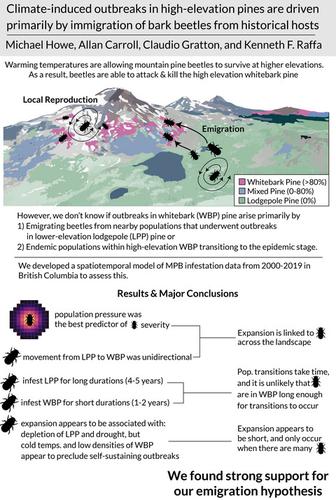当前位置:
X-MOL 学术
›
Glob. Change Biol.
›
论文详情
Our official English website, www.x-mol.net, welcomes your
feedback! (Note: you will need to create a separate account there.)
Climate-induced outbreaks in high-elevation pines are driven primarily by immigration of bark beetles from historical hosts
Global Change Biology ( IF 10.8 ) Pub Date : 2021-08-24 , DOI: 10.1111/gcb.15861 Michael Howe 1 , Allan Carroll 2 , Claudio Gratton 1 , Kenneth F Raffa 1
Global Change Biology ( IF 10.8 ) Pub Date : 2021-08-24 , DOI: 10.1111/gcb.15861 Michael Howe 1 , Allan Carroll 2 , Claudio Gratton 1 , Kenneth F Raffa 1
Affiliation

|
Warming temperatures are allowing native insect herbivores to expand into regions that previously exceeded their thermal tolerance, encounter new host species, and pose significant threats to native communities. However, the dynamics of these expansions remain poorly understood, particularly in the extent to which outbreaks remain reliant on emigration from historical hosts or are driven by local reproduction within novel hosts in the expanded range. We tested these non-mutually exclusive hypotheses using spatially explicit data on mountain pine beetle (Dendroctonus ponderosae), which historically undergoes intermittent outbreaks in low-elevation lodgepole pine (Pinus contorta), but is now causing severe mortality in a high-elevation endangered species, whitebark pine (Pinus albicaulis). We compiled data from 2000 to 2019 across British Columbia, Canada, at 1-km2 resolution, and analyzed spatiotemporal patterns of beetle infestations, lodgepole pine distributions, expansion into habitats dominated by whitebark pine, and the likelihood of future outbreaks in all pine communities under simulated conditions. Overall, we found strong support for the hypothesis of emigration from the historical host species continuing to be a major driver of outbreaks in the more recently accessed host. First, beetle population pressure was consistently the best predictor of infestation severity in both lodgepole and whitebark pine, and appeared to be mostly unidirectional from lodgepole to whitebark pine. Second, infestations in lodgepole pine were of a longer duration than those in whitebark pine, which appeared too brief to sustain transitions from endemic to eruptive dynamics. Furthermore, resource depletion appears to drive emigration from lodgepole pine, whereas in whitebark pine drought appears to favor establishment of immigrants although bioclimatic factors and stand structure preclude self-sustaining outbreaks. Finally, we project that most pine in British Columbia will be at risk in the event of a new major outbreak. We describe implications for conserving and protecting whitebark pine and to other climate-driven range expansions.
中文翻译:

气候引起的高海拔松树爆发主要是由来自历史宿主的树皮甲虫的移民驱动的
气温升高使本地昆虫食草动物能够扩展到以前超出其耐热性的地区,遇到新的寄主物种,并对本地社区构成重大威胁。然而,对这些扩张的动态仍然知之甚少,特别是在爆发仍然依赖于历史宿主的迁出或由扩大范围内的新宿主内的本地繁殖驱动的情况下。我们使用关于山松甲虫(Dendroctonusponderosae)的空间明确数据测试了这些非互斥的假设,这种甲虫历来在低海拔的黑松(Pinus contorta)中间歇性爆发,但现在正在导致高海拔濒危物种的严重死亡, 白皮松 (白松)。我们收集了 2000 年至 2019 年加拿大不列颠哥伦比亚省 1 公里2 的数据分辨率,并分析了甲虫侵扰的时空模式、黑松分布、扩展到以白皮松为主的栖息地,以及在模拟条件下所有松树群落未来爆发的可能性。总体而言,我们发现历史宿主物种的迁出仍然是最近进入的宿主爆发的主要驱动因素,这一假设得到了强有力的支持。首先,甲虫种群压力始终是黑松和白皮松侵染严重程度的最佳预测指标,并且从黑松到白皮松似乎大多是单向的。其次,黑皮松的侵染持续时间比白皮松长,白皮松的侵染时间似乎太短,无法维持从地方性到爆发性的转变。此外,资源枯竭似乎推动了黑松迁徙,而在白皮松,干旱似乎有利于移民的建立,尽管生物气候因素和林分结构排除了自我维持的爆发。最后,我们预计不列颠哥伦比亚省的大多数松树在发生新的重大疫情时都将面临风险。我们描述了对养护和保护白皮松以及其他气候驱动的范围扩展的影响。
更新日期:2021-10-15
中文翻译:

气候引起的高海拔松树爆发主要是由来自历史宿主的树皮甲虫的移民驱动的
气温升高使本地昆虫食草动物能够扩展到以前超出其耐热性的地区,遇到新的寄主物种,并对本地社区构成重大威胁。然而,对这些扩张的动态仍然知之甚少,特别是在爆发仍然依赖于历史宿主的迁出或由扩大范围内的新宿主内的本地繁殖驱动的情况下。我们使用关于山松甲虫(Dendroctonusponderosae)的空间明确数据测试了这些非互斥的假设,这种甲虫历来在低海拔的黑松(Pinus contorta)中间歇性爆发,但现在正在导致高海拔濒危物种的严重死亡, 白皮松 (白松)。我们收集了 2000 年至 2019 年加拿大不列颠哥伦比亚省 1 公里2 的数据分辨率,并分析了甲虫侵扰的时空模式、黑松分布、扩展到以白皮松为主的栖息地,以及在模拟条件下所有松树群落未来爆发的可能性。总体而言,我们发现历史宿主物种的迁出仍然是最近进入的宿主爆发的主要驱动因素,这一假设得到了强有力的支持。首先,甲虫种群压力始终是黑松和白皮松侵染严重程度的最佳预测指标,并且从黑松到白皮松似乎大多是单向的。其次,黑皮松的侵染持续时间比白皮松长,白皮松的侵染时间似乎太短,无法维持从地方性到爆发性的转变。此外,资源枯竭似乎推动了黑松迁徙,而在白皮松,干旱似乎有利于移民的建立,尽管生物气候因素和林分结构排除了自我维持的爆发。最后,我们预计不列颠哥伦比亚省的大多数松树在发生新的重大疫情时都将面临风险。我们描述了对养护和保护白皮松以及其他气候驱动的范围扩展的影响。











































 京公网安备 11010802027423号
京公网安备 11010802027423号